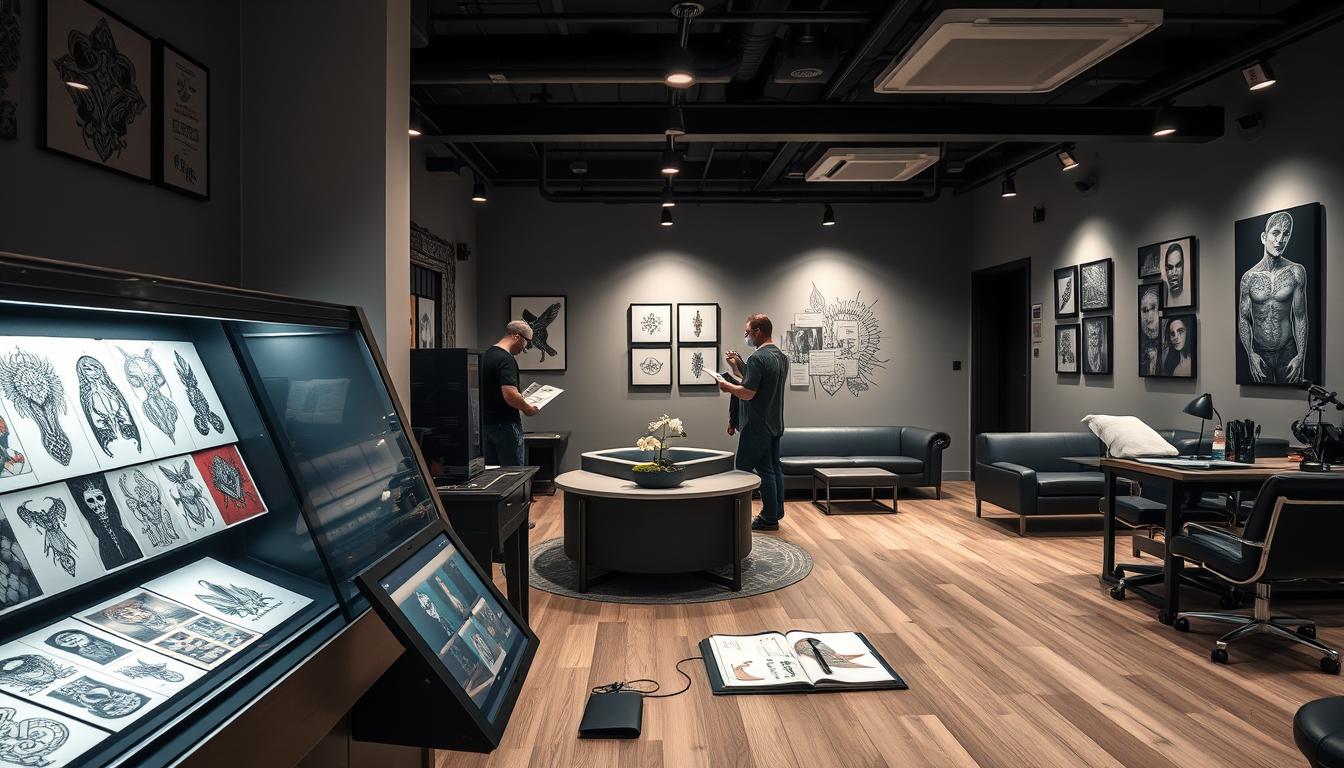
What if the price of your next tattoo said more about its quality than its size? For decades, body art has shifted from underground symbolism to mainstream self-expression. This evolution brings endless creative possibilities—and confusing pricing structures that leave many first-timers scratching their heads.
Modern ink costs aren’t just about paying for needles and ink. You’re investing in an artist’s expertise, studio safety standards, and a design you’ll carry forever. Studios now charge by the hour, by piece, or even offer subscription plans. This variety makes comparing prices feel like decoding a secret language.
Your budget depends on factors like design complexity, placement, and artist reputation. A tiny wrist tattoo might cost less than dinner for two, while a full sleeve could rival a luxury vacation. But quality matters—skimping now might mean paying more later for touch-ups or corrections.
Key Takeaways
- Tattoo pricing reflects artist skill, studio overhead, and design complexity
- Hourly rates typically range between $100-$300 in major U.S. cities
- Smaller designs may have flat fees while large pieces use hourly pricing
- Reputable artists often require non-refundable deposits
- Aftercare products and touch-ups add to the total investment
- Custom designs generally cost more than pre-drawn flash art
Introduction: Exploring Your Tattoo Investment
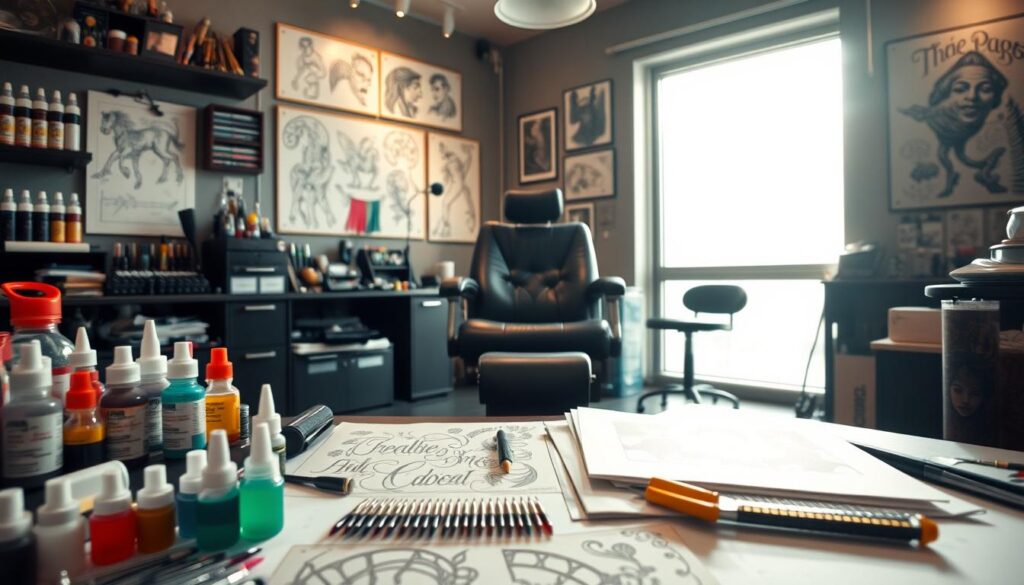
Every tattoo tells a story, but the right artist ensures it’s a masterpiece. The tattoo industry has exploded with over 20,000 studios nationwide, offering everything from minimalist dots to full-body murals. This abundance means you’ve got options—but also requires smart navigation.
Setting Expectations for Your Tattoo Journey
Think of your first consultation like dating—you’re finding someone who gets your vision. Top artists often book months out, and deposits secure your spot. “Great art isn’t rushed,” says Miami ink veteran Lola Marquez. Quality work demands time, both in design and execution.
Budgeting goes beyond dollar signs. Consider travel expenses if your chosen creator works states away. Factor in healing time—can you take days off work? Complex designs might require multiple sessions, spreading costs over weeks.
The Importance of Researching Costs and Artists
Instagram portfolios reveal more than style—they show consistency. Scroll past the highlight reel to see healed results. Check if artists specialize in your desired technique, whether it’s photorealistic portraits or bold traditional art.
Many studios offer free consultations. Use these to discuss pricing transparency. Ask about their sterilization processes—your health isn’t a line item. Remember: skilled artists charge what they’re worth, but they’ll help you prioritize elements if funds tighten.
Your skin deserves thoughtful investment. By balancing research with realistic goals, you’ll wear your story proudly—no regrets included.
How Much Do Tattoos Cost: Breaking Down the Basics
Your dream tattoo’s price tag reveals more than numbers—it reflects craftsmanship, time, and artistic vision. Whether you’re considering a delicate wrist design or an elaborate back piece, understanding typical pricing structures helps align expectations with reality. Let’s explore what shapes these figures and how to assess value beyond the initial quote.
Understanding the Price Ranges for Different Styles
Small symbols or text often fall between $50-$200—ideal for testing your comfort with the process. These pieces usually wrap up in one session, making them accessible for first-timers. Medium designs like forearm florals or shoulder mandalas typically cost $200-$800, balancing detail with affordability.
Large-scale work transforms your body into a canvas. Full sleeves or back murals range from $1,000-$5,000+, requiring multiple sessions and meticulous planning. Artistic mastery shines here—realism or watercolor styles demand advanced techniques that elevate both quality and price.
Why Price Variations Occur
Complex designs eat up studio time. A photorealistic portrait might take 10 hours versus 2 hours for a basic geometric shape. “Detailed work needs breathing room—we can’t rush shading or color blending,” explains Chicago artist Marco Telles.
Artist reputation plays a role too. Seasoned professionals with decade-long careers charge premium rates, while apprentices offer budget-friendly options. Location matters—studio rents in major cities get baked into pricing. Your chosen style’s technical demands also affect the final number, making minimalist designs friendlier to wallets than intricate illustrative pieces.
Factors That Affect Tattoo Prices
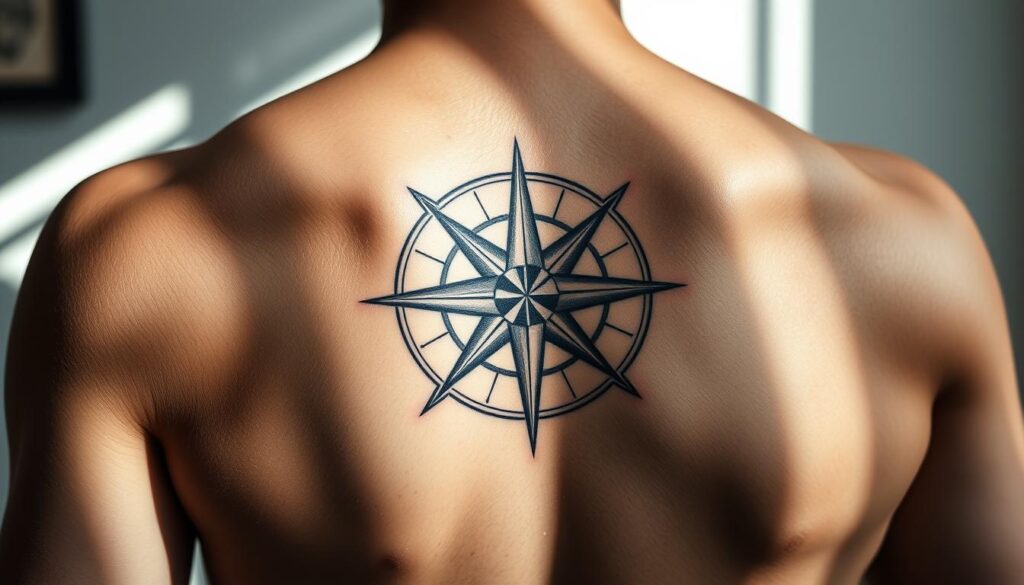
Decoding your tattoo’s cost starts with understanding two key elements: art complexity and anatomy. Your choices here directly shape both the creative process and your budget. Let’s explore what makes some designs pricier than others.
Design Size and Level of Detail
A palm-sized geometric pattern costs less than a full-color sleeve for good reason. Larger designs consume more ink, require extra sessions, and test an artist’s stamina. Intricate linework or shading triples the time needed compared to bold outlines.
Micro-realism pieces demonstrate this perfectly. “Single-inch portraits demand surgical precision—one wobble ruins the whole piece,” notes NYC artist Jenna Choi. These delicate works often cost more per square inch than larger projects due to their technical demands.
Body Placement and Pain Considerations
Your ribcage isn’t just sensitive—it’s a curved canvas that moves with every breath. Areas with thin skin or bony surfaces like feet and collarbones challenge even seasoned professionals. Artists may adjust their technique, slowing their pace to ensure clean results.
Painful spots often mean shorter sessions. More breaks extend completion time, increasing labor costs. Ankle tattoos might require three 90-minute sessions instead of one marathon appointment. Planning for these realities helps avoid budget surprises.
Understanding Tattoo Pricing Structures
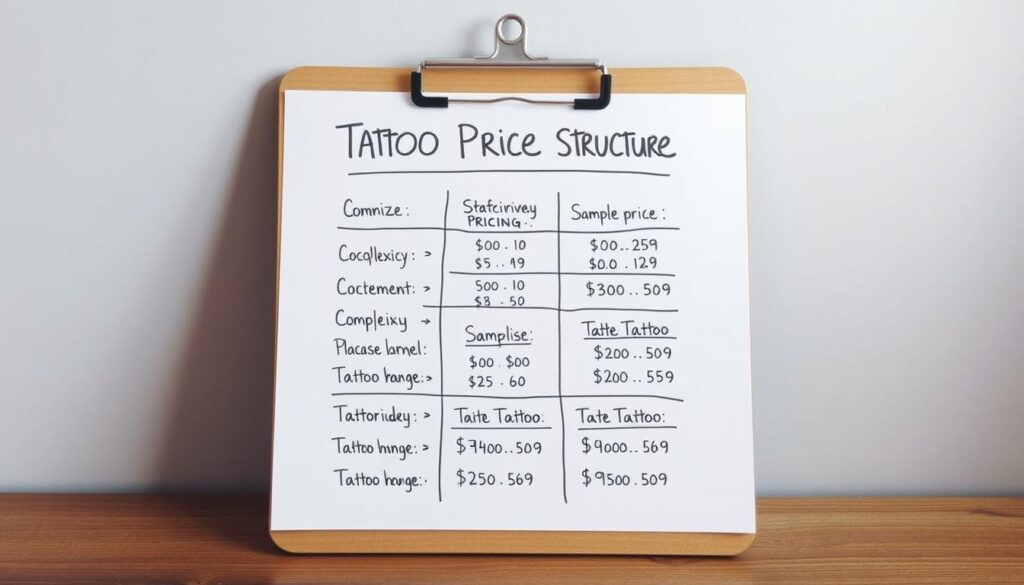
Navigating tattoo pricing feels like learning a new dialect—until you crack the code. Studios use two primary models: hourly billing or flat fees. Your choice depends on design scope, artist preferences, and budget flexibility.
Hourly Rates vs. Flat Rates
Most professionals charge by the hour, with rates spanning $50-$300+ based on skill and location. Hourly pricing works best for custom projects where time estimates fluctuate. As San Diego artist Rico Martinez explains: “Complex shading or client adjustments add hours you can’t predict during consultations.”
Flat fees simplify budgeting for small, predefined designs. Think minimalist symbols or pre-drawn flash art. These fixed rates let you know costs upfront—no surprises if the needle moves faster than expected.
Minimum Charges and Custom Design Fees
Even tiny tattoos have baseline costs. Studios typically set $50-$100 minimums to cover supplies and prep work. This ensures sanitation standards stay high, whether you’re getting a dime-sized heart or elaborate sleeve.
Original artwork often incurs extra fees. Artists spend hours sketching unique designs before ink touches skin. Ask about these charges during consultations—some include them in hourly rates, while others bill separately.
- Hourly models dominate for large/custom pieces
- Flat rates suit simple, quick designs
- Minimums apply to all sizes
- Custom sketches may add 10-25% to total costs
Average Tattoo Prices by Size and Complexity
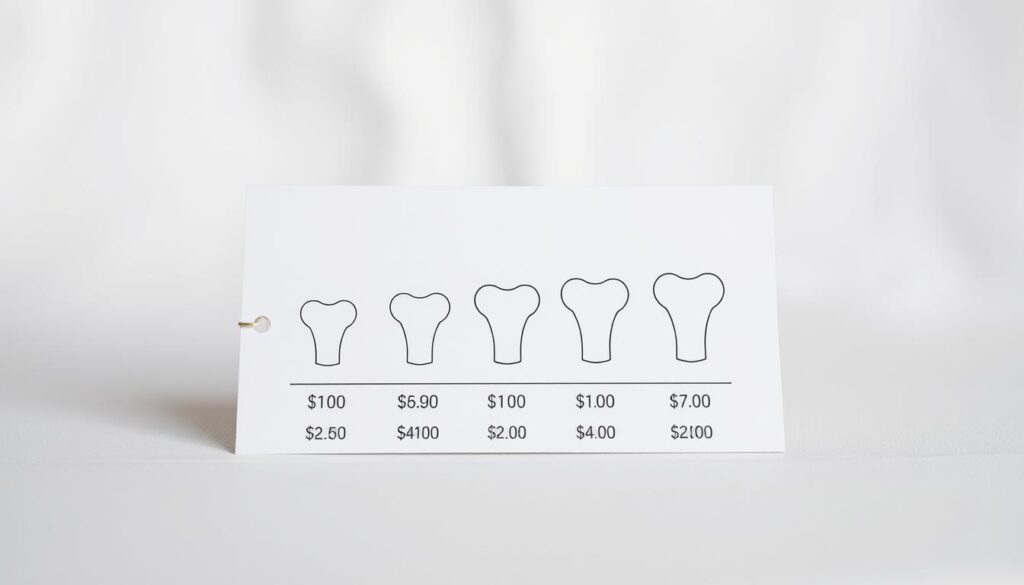
Your tattoo’s size tells half the story—its price reveals the rest. While intricate details and placement matter, understanding average tattoo costs by scale helps you balance artistic vision with practical budgeting. Let’s explore what different-sized pieces typically require financially.
Small, Medium, and Large Tattoo Cost Estimates
Compact designs like initials or minimalist symbols often range from $50-$200. These pieces work well for first-timers or those wanting subtle flair. Simple linework or text usually wraps up in one session, keeping expenses predictable.
Mid-sized artwork—think palm-sized florals or shoulder-spanning mandalas—typically costs $200-$800. This tier offers room for detail without marathon sessions. Half-sleeves or back panels fall here, blending visual impact with manageable costs.
Bold statements demand bigger investments. Full sleeves or back murals range from $1,000-$5,000+, requiring multiple appointments. “Large-scale projects become collaborations—we map progress session by session,” shares Denver artist Clara Ruiz. These pieces showcase technical mastery but need patience and planning.
Remember: these tattoo price ranges shift based on artist expertise and regional rates. A Manhattan studio might charge 30% more than a Midwest shop for similar designs. Always discuss variables during consultations to align expectations.
Budgeting for Your Next Tattoo
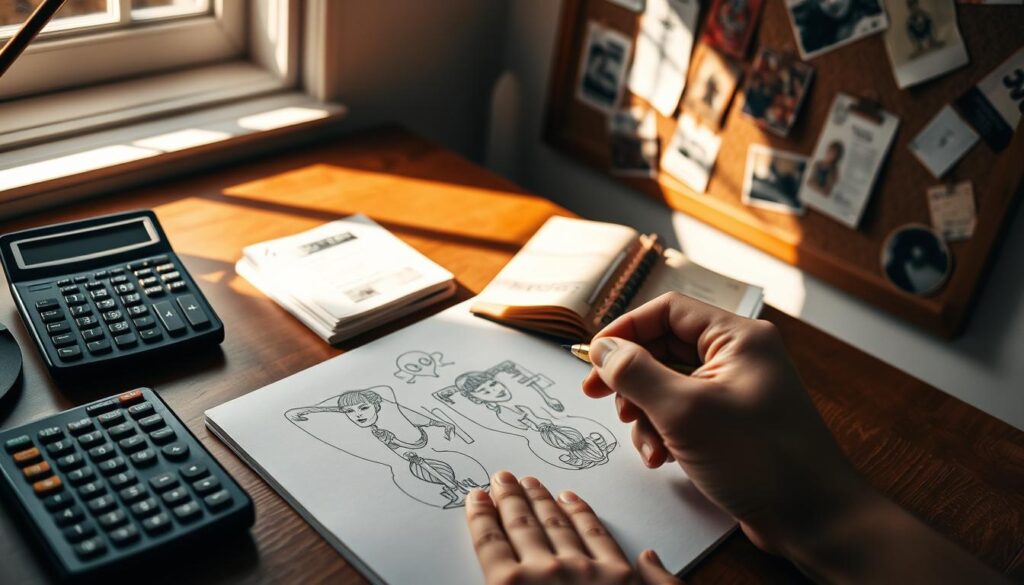
Smart budgeting turns tattoo dreams into wearable reality. Prioritizing quality work means planning beyond the initial price—consider deposits, aftercare, and potential touch-ups. Many studios run seasonal promotions, letting you snag premium designs at friendlier rates.
How to Set Aside Funds Carefully
Open a separate savings account specifically for your body art goals. Automatic transfers build momentum—even $20 weekly adds up. “Clients who save intentionally often upgrade to more detailed pieces,” observes Austin artist Lena Cruz. This discipline helps avoid settling for cheaper options requiring costly fixes later.
Tips for Avoiding Unexpected Expenses
Ask your studio for a written breakdown covering design fees, session minimums, and gratuity. Factor in $30-$50 for healing balms and sunscreen—essential for preserving your ink’s vibrancy. Follow artists on social media for flash sales on pre-drawn designs, especially during slower months.
Seasoned professionals might charge more hourly but often work faster, balancing costs. Schedule consultations early to lock in rates before annual price hikes. Remember: strategic planning today means wearing your story proudly tomorrow—no financial regrets included.
Navigating Artist Experience and Hourly Rates
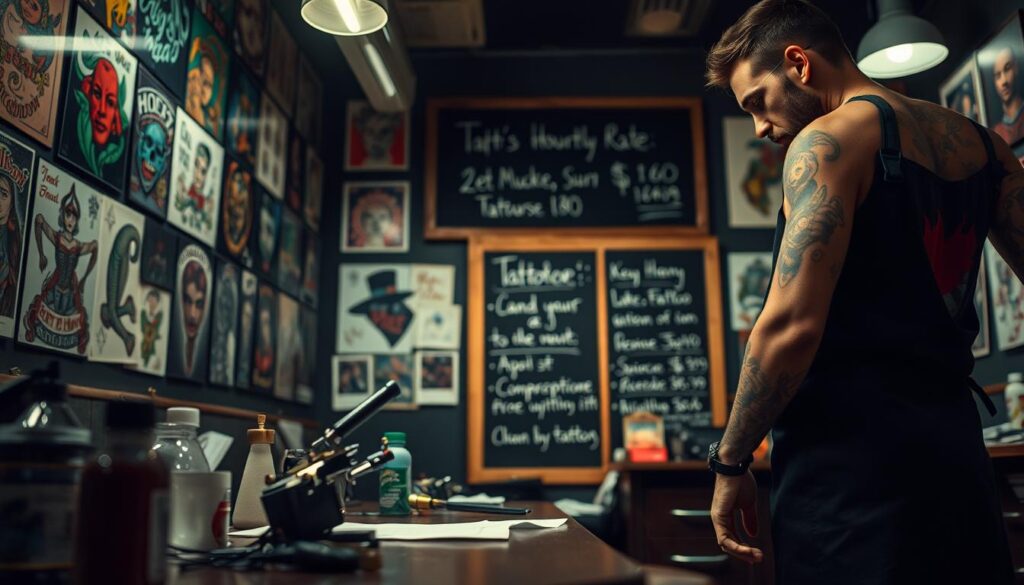
Your chosen tattoo creator’s expertise transforms both your skin and your budget. Like commissioning a painting, the artist‘s mastery level directly shapes your investment—and the artwork’s longevity.
Skill Levels and Corresponding Fees
Emerging artists building portfolios often charge $80-150 per hour. These professionals deliver solid work for straightforward designs, offering value while honing their craft. “New talent deserves opportunities—they’re tomorrow’s masters,” remarks Brooklyn studio owner Diego Ramos.
Mid-career creators with 5+ years experience typically range $150-250 per hour. Their skill ensures cleaner lines and smarter design adjustments during sessions. You’ll see:
- Faster execution without quality loss
- Better pain management suggestions
- Sharper intuition about aging patterns
Elite tattoo artists command $250-500+ per hour, backed by awards or viral fame. Their books fill months ahead, requiring non-refundable deposits. Social media stars might hit $1,000 hourly—reserved for collectors seeking wearable prestige.
Balancing rates and vision matters most. A detailed sleeve justifies premium artists, while a simple symbol might shine through apprentice work. Always review healed pieces in portfolios—true skill shows in how designs mature over years.
Regional Differences and Studio Location Impact
Ever wonder why the same design might run higher in Manhattan than Montana? Where you get inked shapes your budget as much as what you choose. Studio overhead varies wildly—a downtown storefront in Los Angeles carries different costs than a converted garage in rural Ohio.
How Geographic Location Influences Price
Urban centers like NYC or Miami often charge 20-40% more than smaller towns. High rent and demand let top artists set premium rates. Coastal cities also see higher prices due to tourist traffic and local economies.
Midwest and Southern states generally offer friendlier rates without sacrificing quality. Studios in these areas benefit from lower operating costs, passing savings to clients. Seasonal fluctuations matter too—beach towns may hike prices during peak vacation months.
Research local regional averages before booking. A skilled artist in Nashville could execute your vision for less than a comparable creator in San Francisco. Smart travelers combine body art with trips to areas with favorable prices.
Remember: great work exists everywhere, but location always leaves its mark—on both your skin and your wallet.
